Pruning guidebook
The Forest and Range Practices Act and its regulations took effect on Jan. 31, 2004. It replaced the Forest Practices Code of British Columbia Act and regulations. Forest Practices Code guidance is presented for information purposes only.
The guidance offered here is still relevant with regard to field practice.
Introduction
Purpose
This guidebook will assist forestry practitioners in meeting legislative requirements with respect to the use of pruning to meet forest health, wildlife, and high timber value objectives. Guidelines are enclosed in text boxes throughout this guide. Guidelines cover the selection of suitable stands, and pruning methods and techniques.
Benefits of pruning
Pruning is the removal of branches from the stem of a tree to promote the production of knot-free or clear wood.
Pruning improves stand and forest values by:
- reducing the size of the knotty core and increasing clear wood production
- improving wood quality of some species by speeding the change from lower value juvenile wood to higher value mature wood
- increasing the log and lumber value by increasing the proportion of clear wood produced
- reducing stem taper
- reducing the impact of white pine blister rust.
Pruning is one component in a complete program of forest management. Limited financial resources and the prolonged time the investment must be carried require that management needs and objectives be clearly identified. In addition, thorough consideration of biological factors surrounding the pruning treatment will ensure that the desired effect is obtained. Consideration of operational factors helps to guarantee that the treatment will be cost-effective and that the resulting timber can be harvested and transported to a processing facility for an acceptable price. Economic factors involved in deciding whether or not to prune are discussed in the section on Economics.
Authority
Pruning
A person who is required to establish a free growing stand on an area under prescription must specify a pruning treatment, including any slash disposal methods, if
(a) control of white pine blister rust is necessary to achieve a healthy, free growing stand within the free growing assessment period specified in the prescription, or
(b) stand densities that are at least 30% lower than the minimum stocking levels for that biogeoclimatic ecosystem set out in the government publication Establishment to Free Growing Guidebook, as amended from time to time, are required to achieve wildlife habitat management objectives approved for the area in the forest development plan that applies to the area under the prescription.
Scope of stand management
The Operational Planning Regulation gives five points that a person preparing a stand management prescription must do to meet the required scope of a stand management prescription.
(a) consider the result of any free growing survey carried out on the area,
(b) ensure that the prescription is adequate to achieve the future stand condition specified in the prescription,
(c) ensure that the prescription is adequate to achieve continued growth of species that are ecologically suited for the area,
(d) ensure that the prescription facilitates the protection of the soil on the area, and
(e) describe any actions required to achieve known landscape level objectives for stand structure and species composition.
Content of stand management prescriptions
Stand management prescription contents pertinent to pruning are listed below. For details on preparing a SMP see the Stand Management Prescription Guidebook. A person preparing a stand management prescription must, for the area under the prescription, ensure that the prescription:
- contains a reasonable evaluation of any forest health factors that exist currently in the area or that may reasonably be expected to occur in the area before the harvest of the next crop and describes the actions that are proposed to deal with those factors,
- sets out the actions that are proposed to abate fire hazards,
- sets out the target future stand condition and proposed treatments, including spacing, pruning and fertilizing and the objectives of those treatments,
- sets out the stand tending treatment requirements.
Silvicultural Practices Regulation
Reports
-Obligation of major license holder under stand management prescription
A holder of a major license who carries out a silviculture treatment specified in a stand management prescription must prepare a report that
(a) contains a summary of the silviculture treatments performed on the free growing stand on the area during the period beginning 2 weeks before the last report and ending 2 weeks before the current report’s submission date under subsection (2), and
(b) specifies whether the silviculture treatment was carried out to fulfill the requirements of a management plan or an agreement under the Forest Act.
A person required to prepare a report under subsection (1) must ensure that the report
(a) is signed and sealed by a professional forester, and
(b) is submitted each year to the district manager on April 15, July 31, October 31 and January 15.
The chief forester may specify the form and content of a report under subsection (1).
Pruning required by legislation
The Silviculture Practices Regulation (see previous section) outlines two cases where pruning is a free growing obligation.
Pruning white pine
Western white pine is often considered a ghost tree when it occurs at levels of a few trees per hectare. These ghost trees are most often left uncut at the spacing stage, and are not counted in the silviculture survey. They are left as potential sources of rust resistance. When western white pine are considered crop trees and counted as a component of the stand, they must normally be pruned as a free growing requirement. Western white pine grown from resistant seed may not require pruning (see Pine Stem Rust Management in B.C. Guidebook).
Pruning western white pine is done:
- to directly remove inoculum from infected trees (threatening cankers)
- to reduce potential infection sites for future white pine blister rust cankers
- to increase the amount of clear bole wood in the tree.
Care must be taken to remove the lower whorl which may be buried. A silviculture prescription must include first lift pruning in order to consider western white pine as a free growing component of the stand. Pruning western white pine is a two-lift system. The first lift is done when the trees are 2.5 to 4 m tall to a lift height of 1.3 m (breast height). The second lift should be done when trees are greater than 5 m. The second lift pruning for white pine is generally considered an incremental treatment and is planned using a stand management prescription. Second lift height must be a minimum of 2.5 m and leave 50% remaining live crown. Refer to the Pine Stem Rust Management in B.C. Guidebook for more information on pruning to reduce the affects of white pine blister rust (Cronartium ribicola).
Guideline
In order to consider a western white pine crop tree as a free growing stem, it normally must be pruned.
Pruning and wildlife habitat management
The greatest increase in understorey vegetation is created by spacing to lower stocking levels. The understorey plant species which will increase in abundance will depend on the ecosystem association. Increased forage may be necessary in a particular ecosystem for one or more wildlife species. Spacing can be prescribed to meet such wildlife habitat objectives specified in higher level plans. Spacing for these purposes can bring densities significantly lower than the minimum stocking level specified for that ecosystem in the Establishment to Free Growing Guidebook. This wide spacing results in larger branch size that can decrease the total value of lumber obtained from the stand.
Where special management areas for wildlife habitat are required in a silviculture prescription, (e.g., deer, elk, and grizzly bear), pruning must be included in the prescription if spacing densities are at least 30% lower than the minimum stocking level. Pruning is required as a free growing obligation in these areas to maintain wood quality. Guidelines for maintaining grizzly bear habitat are in Guidelines for Integrating Grizzly Bear Habitat and Silviculture in Coastal British Columbia.
Guideline
Important wildlife habitat with stand densities that are 70% or less of the minimum stocking level must be pruned to meet free growing obligations.
Ranking stands for optional pruning
The stand selection process must consider both the biological factors associated with pruning and the operability factors. The following stand selection guidelines are for even-aged conifer stands. Consider these guidelines when determining if pruning should be included in the stand management prescription. These guidelines have been written to:
- produce high-value sawlogs containing clear wood
- minimize pruning costs
- maximize return on investment.
Appendix 1 lists the ranking criteria used by the B.C. Forest Service to meet these objectives. These criteria were developed for 3 metre, first lift pruning costs of a maximum of $1000/ha for the interior and $1500/ha for the coast. This ranking criteria must be modified if the objectives of the treatment differ from those shown above. An example of an alternative objective for pruning would be the reduction of fire risk by pruning uneven aged-stands of Ponderosa pine or Douglas-fir.
Consider the biological and economic principles of pruning as stated below, regardless of the treatment objectives.
Pruning principles
-Biology
Artificial pruning removes the lower dead and living branches to hasten the formation of clear wood. Clear wood is produced naturally, but slowly, under the right conditions. Natural pruning occurs in second growth forests as crowns close and lower branches are shaded. This cycle of shading, death, and loss of branches is not completed until late in a tree’s life cycle. The completion of branch loss by natural means is usually later than projected harvest ages. The degree and speed of natural pruning vary with stand density and species. To produce clear wood in rotations of less than 100 years, artificial pruning is necessary.
The death of lower tree branches is a normal consequence of inter-tree competition and self shading. Dead branches remain attached until they break off or rot. If dead branches are pruned, the tree produces clearwood decades sooner than is possible without pruning. As the tree grows after pruning, the pruning scar is covered over. The total time to heal the wound depends on the rate of diameter growth of the tree, branch diameter and other factors. Long branch stubs heal over more slowly. Live knots generally heal over sooner than dead knots.
When pruning, it is important not to cut the branch collar. Minor nicking of the branch collar is acceptable in order to get a close parallel cut. The branch collar is the site of the trees natural healing tissues.
Pruning effects wood quality by influencing the production of knots and hastening production of mature wood. Knots are produced when a tree stem grows over branches. Dead branches lead to the production of loose or dead knots while live branches form tight or live knots. Wood produced within the crown is juvenile wood in addition to being knotty. Juvenile wood tends to have lower density than mature wood.
Removing branches also removes part of the trees photosynthetic capacity. Severe pruning will therefore decrease the trees ability to produce carbohydrates and decrease growth. Pruning according to this guidebook will cause some growth loss for 1–2 years. Do not prune severely and slow long-term tree growth. Young trees are in a stage of rapid growth and high nutrient demand. Pruning of only the lowest branches on a tree will have little effect on tree growth since these branches produce few carbohydrates.
Economics
Pruning is normally done to obtain a higher price for the pruned logs because of their higher proportion of clearwood. The size and shape of the log, plus the size of the knotty core will impact the log’s value. Timely pruning produces a relatively small knotty core, and a thick knot-free shell with high-value clear lumber. Late pruning will create a wider knotty core and less clear lumber. Larger, higher-value clear wood boards can be cut out of logs with large shells of clear wood. The value of clear lumber produced from a pruning treatment can be three to five times greater than comparable knotty boards.
The net present value (NPV), measured in dollars per hectare, of a pruned stand is lower for lower site qualities. There is an optimum stand density to obtain maximum NPV for a properly pruned stand. Above this density you are sacrificing the size of the clear wood shell. Below this density overall stand volume has decreased too much.
Biological factors
Seven biological factors are associated with stand selection for pruning.
Species
Select species with consideration of future market trends and products. Preference should be given to stands where the desired species makes up more than 60% of the stand.
Some species may not respond beneficially to pruning. Spruce (particularly Sitka), amabalis fir, western larch, and western redcedar have buried buds under the bark (adventitious buds) which sprout after pruning. This makes it difficult to obtain clear wood through pruning of these species without returning for several years to remove these newly formed branches. Varied local conditions may change the impact of pruning on these species. Small trials only are recommended to determine if pruning is a feasible treatment on these particular species. Pruning of western hemlock in the interior is only recommended on a trial basis since it may speed up decay by Indian paint fungus.
Guideline
Give preference to stands which have more than 60% of the desired species. Species with adventitious buds are not good candidates for pruning.
Site quality
Choose rapidly growing stands on good or medium-good sites to maximize the investment returns. The increase in wood value from pruning on low-quality sites may not be sufficient to offset the treatment cost. Pruning is currently economically viable on stands of site index 20 or better. A decrease in pruning costs may make lower site index sites candidates for pruning.
Average stand height
The objectives of the pruning project must be clearly stated before the desired average stand height of crop trees at time of pruning can be determined. Objectives must also be considered when deciding the number of pruning entries. The treatment timing and stand height at the time of entry will vary depending on the number of pruning entries. The B.C. Forest Service suggests that 50% of the tree’s height should be left in live crown. This can, on occasion, be dropped as low as 30% live crown, or three whorls remaining on the tree, whichever is greater length. This should be done to obtain a fixed pruning height throughout the stand while accommodating variation in tree height. This guideline ensures that enough photosynthetic capacity remains to supply the nutrient requirement after pruning.
Guideline
To obtain a constant pruning height throughout a stand, the shorter trees may be pruned to leave a minimum 30% live crown or three whorls remaining on the tree, whichever is greater.
Based on leaving 50% crown on a tree, the number of planned pruning lifts[1] and the final log length required, the desired average stand height can be determined. The dominant stems in each stand are taller than the average height and will therefore be above optimum height for the lift. This compromise is necessary to ensure that the majority of crop trees in a stand are of a prunable height.
Note: If the stand is to be pruned only once, it is important to ensure that a minimum desired length of clear
wood lumber can be obtained.
Stand height = 2 x (desired lumber length + stump height + trim)*
* This equation is dependent on leaving 50% live crown on the majority of the stems.
Trim is the wasted wood that can come from either end of the log in order to ensure the finished log length.
If two or three pruning lifts are planned, the stand could be pruned at an earlier age (smaller knotty core, smaller stand height) while still obtaining clear sawlog lengths. Multiple lifts maximize wood value and the production of mature wood.
Guideline
Pruning in multiple lifts allows stands to be pruned early producing a smaller knotty core.
Diameter
Pruning trees in the 5 m to 7 m height range will normally result in small knotty cores and greater production of clear wood. Diameter at time of treatment is related to the optimum time for financial rotation. Treating small trees will encourage earlier harvest ages. Pruning larger trees means they will require more time to yield the volume of clear wood necessary to recover the pruning cost.
The quality of wood is also affected if pruning is delayed. Dead branches, which occur as the live crown lifts, create loose knots and occlude[2] slower than live branches. Pruning larger diameter branches may also result in the formation of bark and pitch pockets and greater grain distortion around the branch stubs.
Guideline
Pruning small diameter trees:
- minimizes the knotty core and maximizes the amount of clear wood produced
- ensures branch scars heal quickly and exposure to pathogens is minimized
- reduces the possibility of bark and pitch pockets forming over the branch scar
- reduces grain distortion around the branch stub.
Branch size and number
The preferred tree for pruning will have small diameter branches and a small number of branches in each whorl. Small diameter branches are easier to cut and occlude faster than larger diameter branches. Fewer branches per whorl are easier to cut and the risk of girdling the tree is low.
Insects, disease and wildlife damage
The presence of trees damaged by insects, diseases, wildlife, or abiotic cause may preclude stand management activities. Details on the threshold levels of this kind of damage and related surveys are presented in the Silviculture Surveys Guidebook. The threshold levels that are most relevant to spacing are listed in the Spacing Guidebook. Stands having an incidence of some diseases, particularly stem rusts (e.g., white pine blister rust), may benefit from pruning treatments done to improve the chance of crop tree survival. Refer to the Pine Stem Rust Management in B.C. Guidebook for more information on pruning to reduce the affects of white pine blister rust.
Local wildlife populations should be considered for their potential impact on pruned stands. An analysis should be made of damaging agents in surrounding stands to determine potential impact on the stand to be pruned. Pruned stands may be damaged by several species of wildlife including porcupines, squirrels, hares, large ungulates and bears. (See Pests of Young Stands Guidebook).
Guideline
Pruning should only be considered in stands that have low current and projected levels of tree damage caused by biotic or abiotic factors. Pruning species such as western white pine can be considered as a preventative treatment.
Stand structure and density
Stands chosen for pruning should preferably have a uniform structure with sufficient stocking over the majority of the area and a narrow range of tree heights.
Inter-tree competition should be low enough, in pruned stands, that each stem grows sufficient clear wood to make the treatment economically viable. Spacing is also a selection process to ensure that the best trees are pruned.
Post-pruning/spacing density
Select post-spacing densities to ensure that growth of pruned trees does not decrease due to inter-tree competition. The return on investment (net present value) is limited if stems are pruned in higher density, slower growing, stands. Prior to harvest, pruned stems should attain a minimum of 10 cm of clear wood on each side of the knotty core at the top end of the pruned section. Figure 1 shows the approximate dimensions of a pruned log at time of harvest. The 3-metre log in the figure shows a knotty core of the maximum desired size and a clear wood shell of the minimum desired size. A primary objective of pruning is to produce as much clear wood as possible in the shortest period of time to maximize future wood values.
Guideline
To maximize the pruning investment, growth should be maintained at levels which encourage the maximum amount of clear wood production.
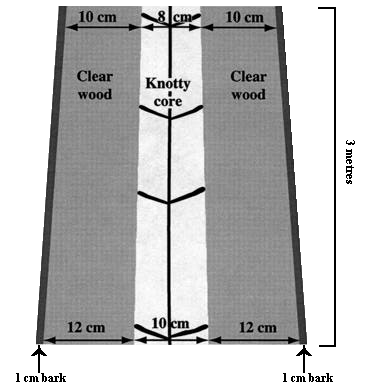
Figure 1. Approximate dimensions of a pruned log (one lift) at time of harvest.
Operational factors
Evaluate any additional treatment costs that can be expected for a particular stand. Stands close to communities with good road access are preferred over more distant or inaccessible stands. Consider other factors affecting future logging costs, such as probable harvesting system and size of block, when ranking stands for pruning potential. Due to the high cost of pruning, the treatments should be restricted to those stands where the risk of land alienation is low.
No special measures for fire hazard reduction are required for a pruning treatment.
Methods and techniques
Timing of pruning projects
The best conditions for pruning occur during cold weather when tree growth is minimal and the tree is dormant. Pruning should be avoided in the spring when the bark is loose and stem damage may be high. Experienced contractors using shears may be able to keep stem damage to acceptable levels when doing spring pruning. Pruning at times other than when the sap is running minimizes bark damage caused by the pruning equipment. Clogging of tools with tree sap is also minimized. Silviculture workers benefit when pruning occurs during seasons not suited for other silviculture work. Stem damage from sun scald may occur in summer months if tree boles are suddenly exposed to severe hot and dry conditions. Amount of damage due to sun scald tends to be species specific. Fall and winter are preferred pruning times.
The diameter of the knotty core should not increase from the first to the second lift, when pruning is done in multiple lifts. This ensures that the size of the knotty core is maintained through the second lift on the stem (Figure 2). Figure 3 shows the impact on clear wood timber production from late and on time pruning regimes.
The cost of pruning has currently restricted treatments funded by government to a maximum of two lifts. To ensure a marketable product can be obtained at the end of two lifts, tree height has been used as the primary factor to determine when the second lift should occur.
Guideline
Pruning should not be done in the spring when the bark is loose and the potential for stem damage is high.
When scheduling second lift pruning consider:
- the average stand height needed to get desired length of clear wood
- the average stand diameter at time of second lift pruning necessary to maintain the same diameter of the knotty core from the first lift.
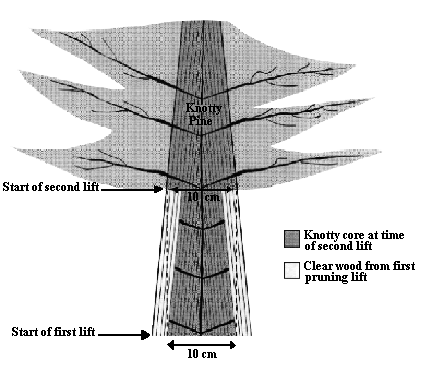
Figure 2. Time the second lift of pruning to maintain the same size of knotty core as the first lift. The second lift should occur no later than when the diameter immediately below the first whorl of branches at the start of the second lift equals the diameter at the start of the first lift.
Maintaining wildlife habitat
Security cover, forage concerns and wildlife trees must be considered before pruning. Pruning activities should also be timed to minimize impacts on known wildlife habitats during breeding, calving, and other sensitive seasons of maximum use.
Security cover
The main impact of pruning on wildlife habitat is the reduction of security cover. Security cover offers concealment from hunters and predators. Some wildlife, such as deer, prefer to be near cover at all times. The existence of cover close to forage and water increases the utility of these resources.
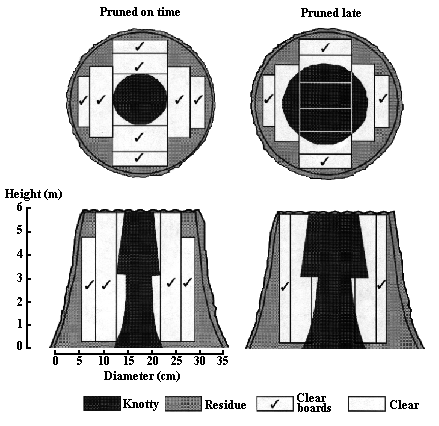
Figure 3. Distribution of clear wood from late and on time pruning regimes.
Where required through consultation with the appropriate government staff, a visual buffer should exist along main and secondary roads in areas with high populations, or hunting pressure, of big game species. A visual buffer, also known as a visual screen, may be provided by topography or vegetation (Figure 4) which blocks the viewing of the interior of the treatment area. In the absence of naturally occurring visual buffers, unspaced buffers should be left at the spacing stage. If such unspaced buffers have not been left, then spaced areas can be left as unpruned buffers. The buffer size depends on the specific site conditions. The width of the buffer should be sufficient that a person or animal walking along the interior edge of the buffer is at least 90% screened from view from the road.
The access management plan for the area should be considered when determining the need for visual buffers along roads. Visual buffers may not be needed if roads are deactivated after the pruning treatment.
A degree of visual buffering may also be achieved by leaving some unpruned trees throughout the stand. Such trees would include poor quality stems (wolf trees), unsuitable tree species (hardwoods), or residuals. Leaving small patches of unpruned trees may also be required to create a visual buffer within the stand or around important wildlife areas such as wildlife trees and riparian zones.
Restricted harvesting practices in riparian management zones will reduce the economic feasibility of pruning in these areas.
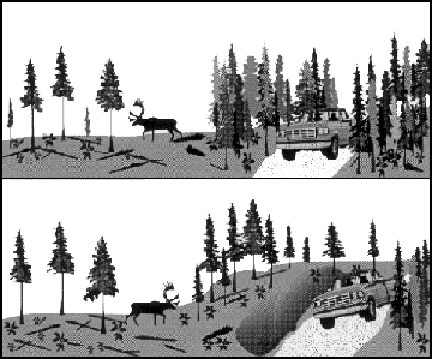
Figure 4. Vegetation or topography can create a visual buffer (from Nyberg and Janz 1990).
Guideline
A visual buffer of unpruned trees along roadways may be necessary to reduce wildlife visibility from the road.
Pruning and lichen
Pruning offers only a minor benefit for creating wildlife forage by increasing light to understorey vegetation. However, pruning reduces the amount of arboreal lichens by that which would grow on the lower limbs. These lichens provide an important winter food source for woodland caribou and mule deer. If areas have been identified as woodland caribou or mule deer winter range then consult forest ecosystem specialists before pruning.
Guideline
Pruning should be restricted in areas where lichen is identified as important wildlife forage.
Wildlife trees
A wildlife tree is a standing dead or live tree with special characteristics that provide valuable habitat for conservation or enhancement of wildlife. In most cases wildlife trees are identified prior to pruning. However, if spacing occurs after pruning, the wildlife trees must be identified and danger trees removed or no treatment zones established prior to the pruning treatment.
Wildlife tree management includes both the retention of suitable wildlife trees at the time of harvest and silvicultural activities, and the recruitment of suitable replacement wildlife trees over the rotation period.
Generally, the safest and most operationally feasible method for managing wildlife trees is to leave a mixture of live and dead standing trees in a clumped distribution (reserves). The location and size of the reserves in a stand will depend on specific site conditions such as availability of high quality wildlife trees, and wind firmness. The amount of wildlife tree area required for any specific unit depends on the level and distribution of existing and planned harvesting on the surrounding landscape. Wildlife tree reserves may be located at the edge of the stand, in areas that are difficult to access or in less productive areas. This location can be done to minimize the impact of the mandatory no-work zone. Refer to the Biodiversity Guidebook for more information on wildlife trees.
Guideline
Maintain wildlife trees in wildlife tree reserves.
The location of these reserves should be consistent with the Biodiversity Guidebook.
Block identification
The area pruned must be suitably identified for future logging operations in order to extract the full value of the pruned stand. The pruned area must be recorded on maps and marked on the ground. Any areas within the block which have not been treated, such as buffers, should also be mapped. Treatments should occur over whole openings, or parts of openings that are clearly delineated by roads, topographic breaks, or similar features. This should avoid sorting confusion during harvesting.
In addition to their location, the size of the trees (diameter breast height and pruning height) at the time of pruning must be known. At rotation age, the amount of clear wood available in each log cannot be visually assessed until the log is processed. The value at rotation cannot be forecast without initially documenting the size of the knotty core.
Guideline
Pruned areas must be clearly marked on forest cover maps.
The dbh of trees at pruning and the pruning height should be documented.
Crop tree selection
Where stocking control is required, pruning can be done before or after spacing. In most cases spacing is done before pruning. If pruning is done first, the pruner is responsible for crop tree selection and should not prune the trees that will later be spaced out. The pruner must select trees following the same criteria for crop tree selection given spacers.
The number of branches in a whorl must also be considered; the most desirable tree has few. Trees with many branches per whorl should be left if pruning may girdle the tree. Pruning costs may also become excessive with many branches to prune.
Guideline
Do not prune a tree if it will result in girdling of the stem.
Pruning mixed species
Most forest stands have a mixture of tree species. The most desirable stands to prune will have a majority ( > 60%) of the desired species. Regardless of the species mix, the key is to maintain rapid tree growth by spacing stands to recommended densities for pruning. Stands at recommended densities for pruning should have all stems pruned if there is concern that pruned trees will lose dominance to unpruned trees. Pruning causes some height and diameter growth loss for 1–2 years after pruning. Unpruned codominants can overtake the selected pruned trees and reduce their growth. This exchange of dominance reduces the return on the pruning investments.
If a species making up a minor component of the stand has adventitious buds these may be left unpruned.
Guideline
Prune all stems in a stand if a change of dominance may occur between pruned and unpruned trees.
Pruning technique
When pruning, cut branches parallel to the bole or main stem and as close as possible without significantly damaging the branch collar (Figure 5). This technique will minimize the time needed for occlusion, or healing over of the scar, and maximize subsequent growth of clear wood. Poor pruning techniques, such as leaving long coarse stubs or scarring the tree, can decrease or eliminate the gains in wood quality, and in some cases kill trees.
Proper lift height must be defined for each stand considering the length of clear wood desired and the height of the trees. If a single lift is planned, the minimum length of clearwood should normally be 3 metres.
Use pruning shears or saws. Do not use an axe or machete to prune branches as these tools can damage trees. These tools may fracture the base of the branch inside the stem, leading to decay and reducing clear wood quality. Do not use chain saws unless they have been modified to successfully protect the stem from scarring. Shears cut close to the branch collar of the tree without the risk of scarring and form a clean cut surface. Cut surfaces that are jagged or have torn fibres take longer to occlude.
Guideline
- Do not use tools such as axes and machetes that remove branches using an impact force.
- Long-handled or telescopic pole pruning saws, or lightweight ladders with pruning shears or saws can be used for the second or subsequent lifts.
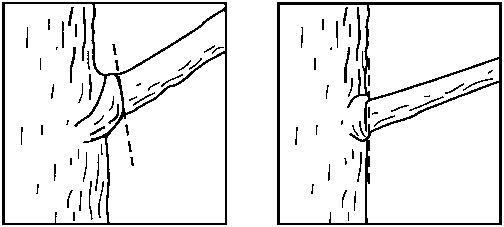
Figure 5. Proper pruning of a branch is a cut as close as possible to the branch collar staying roughly parallel to the stem.
Monitoring and reporting
A pruning project should be monitored for compliance with any treatment standards set out in the stand management prescription or silviculture prescription. The default treatment standard is listed in the guideline below. The B.C. Ministry of Forests will perform monitoring of pruning projects using the methodology described in the Ministry of Forests Silviculture Contract for Stand Tending – Pruning, Schedule A (FS 348A). The minimum acceptable performance quality is 75%. The main considerations are listed in the following guideline.
Guideline
Properly pruned trees must have:
- all branches greater than 3 cm long removed up to the proper lift height with a minimum of 3 whorls remaining or 30% live crown, whichever is greater
- no more than two small attached branches (less than 3 cm long) below the pruning lift height
- branches cut flush with the branch collar, with a 0.5 cm or less stub (measured from the branch collar)
- no scarring of the stem exposing the cambium layer over an area greater than that of the largest pruned branch scar on the tree.
Guideline
The minimum acceptable performance quality is 75% as measured by the Ministry of Forests procedure.
Reporting of accomplishments under SMPs
Reporting of stand management prescription accomplishments on free growing stands is required for major license holders. The Silviculture Practices Regulation requires that a treatment report is submitted quarterly to the district manager. This report must:
- include a summary of the silviculture treatments accomplished on specified areas, including pruning. Pruning information should include species, dbh, pruning height, total stems per hectare, and a location map.
- cover the period beginning two weeks before the last report date and ending two weeks before the current report’s submission date
- be signed and sealed by a professional forester.
The submission dates are April 15, July 31, October 31, and January 15. Pruning done by the Small Business Forest Enterprise Program should be reported following ministry procedures.
Appendix 1: Stand selection guidelines for use in stand management prescriptions
These stand selection guidelines are intended to aid in the evaluation and selection of appropriate sites and pruning treatments for inclusion in stand management prescriptions. The guidelines are ranked from most desirable (1) to least desirable (3) with some stands ranked as treatment Not Recommended (NR). These guidelines are designed to aid in stand selection for first lift pruning up to 3 m and second lift pruning to 5.5 m. Once stands have been selected using these guidelines, financial factors should be evaluated on the selected stands to ensure an acceptable return on the pruning investment. Economic factors involved in deciding whether or not to prune are not addressed in this guide.
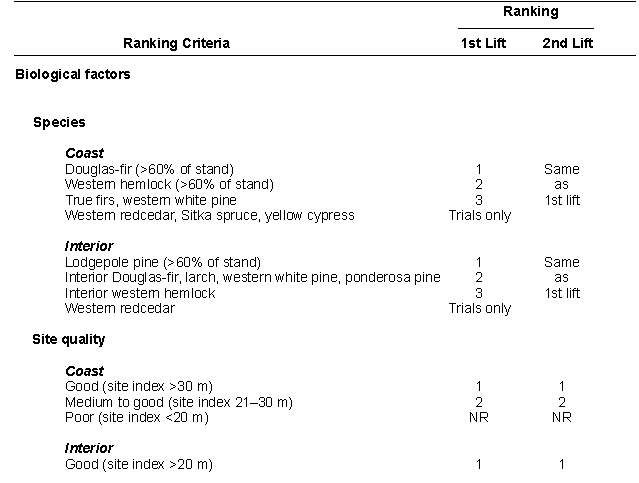
Appendix 2: List of referenced guidebooks
- Stand Management Prescription Guidebook
- Pine Stem Rust Management in B.C. Guidebook
- Silviculture Surveys Guidebook
- Spacing Guidebook
- Pests of Young Stands Guidebook
- Biodiversity Guidebook
- Establishment to Free Growing Guidebook
